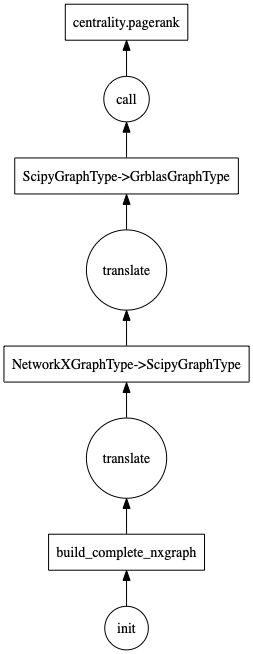Usage with Dask¶
Dask is integrated into Metagraph to allow algorithms and translations to be run in Dask task graphs, and to accept Dask data structures as input.
Most libraries which integrate Dask attempt to require as few changes to a user’s code as possible to move from standard mode into Dask mode (often simply a new import).
For example, here is basic Numpy code:
import numpy as np a = np.arange(100) result = sum(a + 1) result
5050
And here is the same code written using dask.array, the equivalent of a numpy array:
import dask.array as da a = da.arange(100) result = sum(a + 1) result.compute()
5050
The DaskResolver¶
The primary element of Metagraph that is replaced for usage with Dask is the Resolver. A new DaskResolver
wraps a Resolver and intercepts translations and algorithm calls, adding them to the task graph rather than
executing them directly.
To access the default Dask resolver, use metagraph.dask.resolver.
Here is basic Metagraph code to translate between types:
import numpy as np import metagraph as mg res = mg.resolver x = res.wrappers.NodeMap.NumpyNodeMap(np.array([5, 4, 3, 2, 1])) y = res.translate(x, res.types.NodeMap.PythonNodeMapType) y
{0: 5, 1: 4, 2: 3, 3: 2, 4: 1}
And here is the same code using the Dask resolver:
import numpy as np import metagraph.dask as mgdask dres = mgdask.resolver x = dres.wrappers.NodeMap.NumpyNodeMap(np.array([5, 4, 3, 2, 1])) y = dres.translate(x, dres.types.NodeMap.PythonNodeMapType) y
<types.PythonNodeMapTypePlaceholder at 0x7fbd6dc78290>
The result is a Placeholder object which knows that it will be a PythonNodeMapType object,
but it hasn’t been computed yet. To do that, call .compute() on the object.
y.compute()
{0: 5, 1: 4, 2: 3, 3: 2, 4: 1}
There is also a way to make the Dask resolver the default resolver.
This would allow a call to mg.translate() to delegate to the Dask resolver instead of the default.
Custom Dask Resolvers¶
Creating new Resolvers is an advanced feature that most users of Metagraph won’t need. However, if you do
need to create a custom Resolver, converting that into its lazy equivalent is easy – simply wrap it in
metagraph.dask.DaskResolver.
from metagraph.core.resolver import Resolver from metagraph.dask import DaskResolver custom_resolver = Resolver() custom_resolver.register(...) # register whatever pieces are desired lazy_resolver = DaskResolver(custom_resolver) # Now `lazy_resolver` has the same registered items, but operates lazily
Placeholders¶
A Placeholder is the Dask equivalent of a ConcreteType and each concrete type will have a corresponding
class in the Dask resolver. The class name is the name of the concrete type with “Placeholder” tacked on as
as suffix.
For example, NetworkXGraphType has a NetworkXGraphTypePlaceholder class.
The purpose of Placeholders is to delay computation while still providing information to Metagraph about the resultant type, allowing further chaining of the delayed computations.
This is an example of chained operations showing how Placeholders function:
x = dres.wrappers.NodeMap.NumpyNodeMap(np.array([5, 4, 3, 2, 1])) y = dres.translate(x, dres.types.NodeMap.PythonNodeMapType) print(type(y)) z = dres.algos.util.nodemap.apply(y, lambda n: n * n) print(type(z)) z.compute()
<class ‘types.PythonNodeMapTypePlaceholder’><class ‘types.PythonNodeMapTypePlaceholder’>{0: 25, 1: 16, 2: 9, 3: 4, 4: 1}
y is a Placeholder, but Metagraph is able to use it as input to util.nodemap.apply because the
type is known. Properties are not know at this time, so failure may still occur when the result is computed,
but it allows for the general workflow of translations and algorithm calls to be built into a task graph
via intermediate Placeholder objects.
DelayedWrapper¶
In addition to translations and algorithm calls, building of the data objects can also be delayed. Indicating the resultant type is still a requirement for these delayed objects to work in Metagraph.
A DelayedWrapper functions similar to dask.delayed, but wraps a constructor and passes in the resultant
type.
As an example, create a delayed constructor for building complete networkx graphs.
import networkx as nx import itertools def build_complete_nxgraph(num_nodes): g = nx.DiGraph() for src, dst in itertools.product(range(num_nodes), range(num_nodes)): g.add_edge(src, dst) return res.wrappers.Graph.NetworkXGraph(g) nx_complete_factory = dres.delayed_wrapper(build_complete_nxgraph, res.types.Graph.NetworkXGraphType) print(nx_complete_factory)
DelayedWrapper<NetworkXGraphType>
nx_complete_factory is a delayed constructor which return objects that are of type NetworkXGraphType.
Calling it using the same signature as the function build_complete_nxgraph will yield a
NetworkXGraphTypePlaceholder object whose construction has been delayed.
my_graph = nx_complete_factory(100) my_graph
<types.NetworkXGraphTypePlaceholder at 0x7fbd51122590>
Because my_graph is a Placeholder, it can be used in algorithm calls and translations by the Dask resolver.
Visualizing the task graph¶
One very nice benefit of building up a Dask task graph is that Dask comes with builtin visualization features.
Let’s take my_graph from above, translate it, and call an algorithm. Before actually computing anything,
we will visualize the steps Metagraph will take.
g2 = dres.translate(my_graph, dres.types.Graph.GrblasGraphType) pr = dres.algos.centrality.pagerank(g2) pr.visualize()

The translation from NetworkXGraph to GrblasGraph actually required two steps, so both are represented
in the task graph.
Calling pr.compute() will perform all of these steps, from building the complete graph to
translating and finally returning the nodemap of pagerank values.